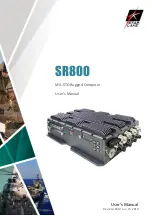
Section 2 - Crane Safety (Continued)
Telemotive Laser Guard Instruction Manual – October 2009
5
2-8.
Boarding The Crane.
The crane should not be boarded without permission
of the supervisor.
The crane operator should turn off the transmitter and
take it with them when boarding the crane.
If more than one person is boarding the crane, one
person should be made responsible for ensuring all
personnel are off the crane before the system is
returned to operation.
2-9.
Crane Repair.
Minor repairs include routine maintenance and
repairs such as greasing, cleaning and control
troubleshooting. All other repairs should be
considered major. If the repair crew consists of more
than one person, one person should be designated as
the repair crew leader with the following
responsibilities. If the repair crew consists of only
one person, that person has the following
responsibilities:
Warning signs should be placed on the floor beneath
the crane or suspended from the crane. For major
repairs, the floor area below the crane should be
roped off.
When major repairs are to take place, all persons
operating other cranes on the same or adjacent
runways, if any, must be notified prior to starting
repairs. Notification should include the nature of the
repair, safeguards provided, and movement
limitations while repairs are in progress.
When practical, radio controlled cranes which cannot
be moved during repairs must be protected against
being bumped by other cranes on the runway.
Bumpers should be installed on the exposed side or
sides of the crane under repair. They should be
placed as far away as possible. The location of these
bumpers should be indicated by red lights placed so
that they are clearly visible to other crane operators
traveling on the same runway. When it is not possible
to use bumpers, red lights must be placed so they are
clearly visible to other crane operators traveling on
the same runway to indicate the restricted travel zone.
All crane operators on the same runway must be
informed of the repair effort and thoroughly
instructed to what their operations are limited to and
informed they will be notified when repairs are
completed.
If any hazard involving the repairmen exists when
there is a runway adjacent to the crane under repair,
the adjacent runway should be blocked off as
described above. When it is necessary to continue
crane operation on the adjacent runways warning
lights must be installed and be visible to operators of
cranes on those runways. All cranes should come to a
complete stop prior to entering the restricted area and
should proceed through this area only after receiving
permission from a signal person designated for this
purpose. Access of persons to and from the crane
being repaired should be under control of the repair
crew leader.
When boarding the crane, the transmitter should be
turned OFF and the transmitter should remain with
the repair crew leader. The leader should board the
crane first, open and lock out the main switch, and
then signal the other members of the crew it is safe to
board the crane.
If work on the crane is to be done in areas not
protected by standard handrails, the repair crew
should wear approved safety belts.
All tools and equipment should be moved onto the
crane by the use of hand lines. The tools and
equipment should be adequately secured to the hand
lines.
If it is necessary to have the crane control circuits
energized, all power circuits for crane movement
must be opened prior to energizing the control
circuits.
All personnel and tools should be moved to a safe
spot before moving the crane during repairs.
Headroom is at a minimum in some crane cabs and
on some crane walkways. Caution should be
exercised when boarding or working on cranes. Hard
hats should be worn whenever possible.
When repairs are finished, all personnel, tools and
repair equipment should be removed before
energizing the crane circuits.
2-10.
Using The Crane As A Work Platform.
When the crane is to be used as a stationary work
platform, follow all rules provided in "
Crane Repair
"
section.
When it is necessary for the crane to be moved from
time to time, the crane operator should board the










































